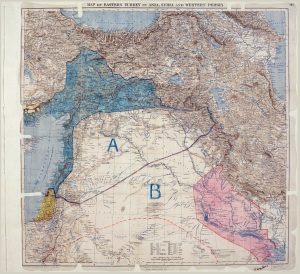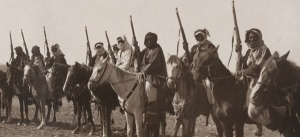For almost a century two guys named Sykes and Picot have ruled over the Middle East. Maybe not ruled as directly or violently as, say, Saddam Hussein or Bashar Al-Assad, but these two have caused more destruction than the Iraqi and Syrian presidents combined despite their deaths 95 and 63 years ago, respectively.
Unless you took a Politics of the Middle East course in college (and remember what you learned in said course), are a scholar of International Relations, or a journalist who specializes in the region, you’ve probably never heard of Sir Mark Sykes or François Georges-Picot. Or, for that matter, their agreement, oddly enough called the Sykes-Picot Agreement. In 1916, the two men divided up the Ottoman Empire between the Allied Powers, primarily Britain and France, in anticipation of their victory in World War I. If you want to pretend that you know anything about the Syrian Civil War or ISIS, Sykes and Picot are a good place to start.
In the agreement, Sykes and Picot established that Britain would ‘get’ Mesopotamia – the Ottoman provinces of Basra, Baghdad – and  Palestine (which at the time included what is now Jordan), while France would control greater Syria including the Levant (Lebanon). Initially France also claimed the Ottoman province of Mosul, but it would end up going to Britain in the San Remo Conference (because oil).[i] Essentially, the Middle East would look like on the right, which comes directly from the original negotiations. The blue and red bits would come under direct French and British control (or administration to use the ‘politically correct’ lingo of the day), while the parts marked A and B would be considered ‘protectorates’. What this meant was each had first dibs on anything found there, like oil, whose geopolitical importance was growing more apparent by the day.
Palestine (which at the time included what is now Jordan), while France would control greater Syria including the Levant (Lebanon). Initially France also claimed the Ottoman province of Mosul, but it would end up going to Britain in the San Remo Conference (because oil).[i] Essentially, the Middle East would look like on the right, which comes directly from the original negotiations. The blue and red bits would come under direct French and British control (or administration to use the ‘politically correct’ lingo of the day), while the parts marked A and B would be considered ‘protectorates’. What this meant was each had first dibs on anything found there, like oil, whose geopolitical importance was growing more apparent by the day.
To be honest, it’s not quite fair to blame these two personally for all the death and destruction that has defined the Middle East for the greater part of the last century. Sykes and Picot were just acting out their respective country’s colonial foreign policy: control as much of the globe as possible. Dividing up foreign lands from armchairs in stuffy, presumably smoke-filled lounges with whiskey-tainted breath had pretty much been Western Europe’s modus operandi for the better part of two centuries. But the ‘War to End All Wars’ was changing that. New powers like the United States and revolutionary movements like Socialism, combined with the spread of Nationalism, began to question the status quo of colonialism and a novel concept called ‘self-determination’ was coming into vogue. This was where native peoples could rule themselves rather than having a European metropole colonize them and profit from their natural resources.
In a Snowden-esque turn of events, just over a year after Sykes and Picot had arbitrarily carved up the cradle of Western Civilization unbeknownst to its inhabitants, the new Bolshevik government in Russia leaked the agreement to the relative embarrassment of both the British and French. The leak came just weeks after the British government had openly supported Jewish homeland in Palestine in a letter from Foreign Secretary Arthur Balfour to Baron Rothschild, a leader in the influential but controversial Zionist movement. So within a month, November, 1917, the Arabs who had fought with Britain against the Ottoman Empire and who were promised self-determination by British Colonel T.E. Lawrence (this guy) in exchange for said fighting, found out that; a) a portion of their territory would be probably given to Jewish settlers and b) the rest of it would be divided between two colonial empires. They weren’t happy and briefly tried to fight the French for Syria but were quickly defeated.
*
Sir Mark and François probably realized that their agreement would be awkward if it ever went public, hence all the secrecy, but when their plan was leaked, it was only so awkward that the Allies convened the Conference of San Remo that cemented the borders drawn by Sykes-Picot into international law with a few caveats; namely, each of these Mandates would be ‘independent’ but administered (read: ruled) by the aforementioned Powers until “they are able to stand alone.”
What followed over the next ninety years or so was the institutionalization of Sykes-Picot; Iraq, Syria, Lebanon, Jordan, Israel-Palestine and to a certain extent Saudi Arabia and Iran, all owe their borders directly to these two men sitting down and drawing lines on a map. And borders, in the age of the United Nations, are sacred. It takes an enormous amount of death and destruction before the idea of changing borders is ever placed on the diplomatic table. One only must look as far as Sudan, Yugoslavia (which, presumably because of its proximity to Western Europe, was relatively quick and easy) and Somalia for evidence of this.
Jump to 2003 and the American invasion of Iraq, which destabilized a country that was only stable in the first place because of a strong, secular central government that crushed any sort of dissent by gassing the ‘rebellious’ portions of its population until they gave up. I’m speaking of course about Saddam Hussein, but he wasn’t alone in killing tens of thousands of his ‘own people’ in the name of his state.
In Syria, Bashar al-Assad’s father, Hafez al-Assad massacred upwards of 40,000 members of the Muslim Brotherhood in 1982 after a decade of oppressing them in other fun ways. Same with the military regime in Egypt – the West’s, and especially America’s, ally since they made peace with Israel in return for billions of dollars worth of military support – whose suppression of the Muslim Brotherhood (combined with the peace, seen by many as a betrayal of the Arab-Muslim world) from the early 1960’s on, gave birth to the origins of the Sunni-Militant Islam we see today via the work of Sayyid Qutb, a founding father of the movement, and others.
All three of these countries, Iraq, Syria and Egypt, and the military-secular regimes that governed them, were part of the pan-Arab movement, a secular, socialist ideology that was founded in the wake of the Second World War to try and recoup what the Arab people felt they had lost in Sykes-Picot and San Remo, namely a unified Arab state. But after Egypt and Syria made an ill-fated attempt at unification between 1957 and 1961 and a split in the pan-Arab, Ba’ath party between Iraqi and Syrian factions in 1966, alongside successive defeats to Israel in 1967 and 1973, the Pan-Arab ideology lost its momentum and has never come close to getting it back. Replacing that Pan-Arab identity were transnational (or at least trans-border) religio-cultural identities, which is just an erudite way to say Shia-Sunni as in Iraq or Shia-Sunni-religious minority. These identities were made worse by the now well-known regional struggle between Saudi Arabia and Iran that has been festering in its current incarnation since the Iranian Revolution in 1979.
What these geo-political shifts hinted at, the 2003 invasion and subsequent Iraqi and Syrian Civil Wars have laid fully bare: the current borders in the Middle East – those drawn by Sir Mark Sykes and François Picot 98 years ago – should not exist. More to the point, the current conflagration in the Fertile Crescent, diagrammed here by ThinkProgress, has become so complicated that the US and Iran have become allies. As complex as it is, Ryan Faith of ViceNews has done a standup job of outlining the “Teams” involved. Faith’s series is a well-informed snapshot of who’s who, right now. And that’s great, but looking five/ten years down the road, things start to get even cloudier.
*
There has been a decent amount of debate, going back to 2008, about whether the end of Sykes-Picot is nigh, whether, in the next few years, we’ll see massive political upheaval resulting in a drastic changing of borders and formation of ‘new’ states. This is where on-the-ground realities start to look international law in the face and say, “You’re full of shit.” Sykes-Picot and its framework have actually been failing for 30-some-odd years now, if it ever succeeded, or for that matter existed, in the first place.
In the West, we have this notion that the entire world should, must, and does comply to the norms of the international system – and granted much of it does. Academically known as the Westphalian System, it was first created in Western Europe in the 17th century and, after the World Wars, eventually spread to the rest of the globe via decolonization. The Westphalian System is basically the idea that states, based around upon communal ‘nation’, are the primary actors in international relations and that the sovereignty of states, based upon their borders, is more or less sacred. This concept was imposed on the Middle East (and Africa, but that a whole other story) in the first half of the 20th century, by men like Sykes and Picot, with very little attention given to pre-existing power structures or identities.
World War I and its aftermath was the beginning of modern Western engagement and policy in the Middle East. Yet in introducing the concept of the state to the region, the very founders of the system (Western Europeans) ignored the fundamentals. For example, giving statehood to a pre-existing ‘nation’, the Kurds (who I have done a very big disservice in not mentioning and deserve a much larger amount of space than I am able to give them here). It seems appropriate now, in arguably the worst violence the region has seen in the past century, to return to that beginning and reassess it all. What has been created in the Middle East are a series of, what renowned scholar of sovereignty Robert Jackson calls ‘quasi-states’, essentially states that are recognized by international law (de jure) but whose power, that all-important foundation of statehood, in cold, hard, reality (de facto), exists in little more than lines drawn on a map. As a matter of fact, that’s how it all began.
[i] The French gave the British control of Mosul in 1918 when the latter found oil in the region and convinced the French government to let them have it, primarily by allowing them free reign in across greater-Syria (and conceivably by reminding them how they had saved their asses in 1914).


Pingback: What happens when the Islamic State isn’t defeated? | The Volterra